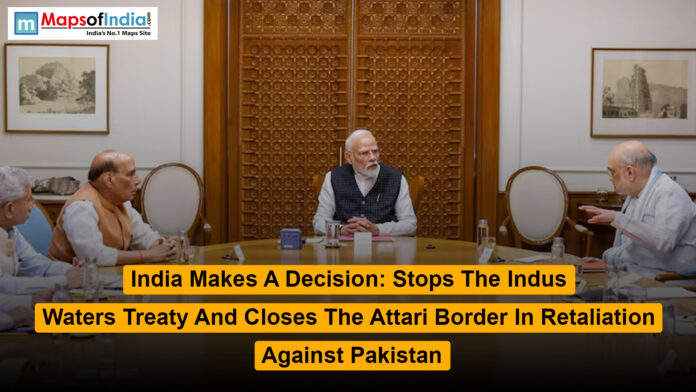India Makes a Decision: Suspends the Indus Waters Treaty and Closes the Attari Border
India–Pakistan tensions are at an all-time high. Disagreements and skirmishes have escalated in recent weeks, putting the two nations in danger of going to war. India has declared its intention to revoke the Indus Waters Treaty, a crucial pact that regulates the two countries’ water sharing. This is an important step because the treaty controls water supplies that are essential to daily life and agriculture in both countries. India has also announced plans to close the Attari border, a significant site of crossing between the two nations. Concerns for more escalation and trade interruptions are raised by this action. Both measures are noteworthy because they have a direct bearing on border security and water availability, two delicate topics essential to South Asian regional stability.
For many years, a peaceful method of managing common water resources has been the Indus Waters Treaty, which was signed in 1960. The treaty’s suspension or termination might lead to conflicts over water rights and use, which could have detrimental effects. Millions of people may be impacted by the border closure’s anticipated effects on communication, travel, and trade.
There may be more violence or perhaps a military conflict as a result of these events, experts caution. Deeper, more persistent problems relating to land disputes, security issues, and political rivalry are reflected in these recent actions. They might cause more instability in the area, endangering the tenuous peace that has endured for many years.
This article examines the rationale behind India’s choices, their effects on both countries, and potential future developments. To understand why the situation is so dire and why the potential for conflict is increasing, one must have a solid understanding of these issues.
The Indus Waters Treaty: Historical Context and Significance
The 1960 Indus Waters Treaty was created to settle India and Pakistan’s long-standing disagreements over water use. The World Bank, which was instrumental in getting both countries to the bargaining table, provided help during the negotiations. The pact is important since it delegated authority to the six main rivers of the Indus River system: the Indus, Jhelum, Chenab, Ravi, Beas, and Sutlej.
The agreement granted Pakistan rights to the western rivers, the Indus, Jhelum, and Chenab, while giving India authority over the eastern rivers, the Ravi, Beas, and Sutlej. The goal of this divide was to lessen disputes over water rights, which are vital to both nations’ industries, drinking water, and agriculture. For more than 60 years, the pact has endured despite multiple bilateral disputes and changing political environments. It is regarded as one of the world’s most resilient water-sharing pacts and has established a standard for amicable collaboration in an area sometimes beset by geopolitical competition.
The pact has encountered difficulties despite its duration. India, which alleges that Pakistan occasionally manipulates upstream flows to its benefit, is concerned about Pakistan’s usage of water from the western rivers. While this is going on, Pakistan highlights the importance of the agreement by highlighting how these rivers are vital to its daily needs and agriculture. Although these disagreements have caused diplomatic tension, the treaty’s general structure has remained stable.
The Indus Waters Treaty’s continuous existence emphasizes how crucial it is to preserving peace. It provides a formal dispute resolution process that necessitates frequent contact and cooperative resource management between the two countries. According to experts, it has been a major success in regional diplomacy and has prevented more serious confrontations.
Details of India’s Decision to Stop the Indus Waters Treaty

Reasons Cited by India for Terminating the Treaty
India has stated that its decision to end the water-sharing treaty with Pakistan is driven by serious national security concerns. The country says recent terrorist attacks have made it clear that it must take stronger steps to protect itself. India believes that Pakistan supports insurgent groups that are actively working against India’s safety. These groups are accused of crossing the border to carry out attacks on Indian cities, military bases, and infrastructure. Such actions have heightened fears that the border is not secure enough and that these groups could instigate violence at any time.
India points to specific incidents to support its claims. For example, there have been multiple attacks in recent years attributed to these insurgent groups, leading to loss of lives and damage to property. Many experts agree that terrorist groups often operate from Pakistani territory or receive support from elements within the country. These groups aim to destabilize India and create chaos, making security a top priority for New Delhi.
By ending the water-sharing treaty, India hopes to make a clear statement. It wants to reinforce its sovereignty and show strength in defending its borders and citizens. The water treaty historically allowed India and Pakistan to share water from rivers that flow through both countries, such as the Indus River. This water is vital for millions of people on both sides for farming, drinking, and industry. Ending this treaty is a way for India to assert control over its resources and signal that it will not be vulnerable to water being used in future conflicts.
India also aims to prevent water from becoming a weapon in any future conflict. Pakistan could choose to cut off the water supply or use water restrictions as a means of pressure. India wants to make it clear that any such move would be seen as an act of aggression. The decision to end the treaty shows India’s determination to defend its borders, secure its water supplies, and send a message to any adversaries that it will not be taken lightly.
This move is part of a broader strategy by India to tighten security and protect its national interests. It reflects the ongoing tensions and complex relationship between the two countries. By taking control of shared resources and reinforcing security measures, India signals that it will prioritize its safety above all. The situation remains fragile, and both countries continue to watch each other closely for any signs of escalation.
Legal and Diplomatic Implications
Ending an international treaty is complex. India says it will follow legal procedures to terminate the treaty officially. Pakistan responded with outrage, calling it a breach of international commitments. The World Bank and other members of the international community have voiced their concerns. This move could set a dangerous precedent for how transboundary water agreements are treated worldwide.
Regional and Global Reactions
Neighboring countries reacted anxiously. Some, like Afghanistan and Nepal, called for peaceful dialogue. India and Pakistan were asked by the World Bank to resolve their differences amicably. Major powers like the US and China issued cautious statements urging restraint. If similar treaties break down, it could affect water diplomacy elsewhere, increasing global instability.
Closure of the Attari Border: Strategic and Political Ramifications
The Attari border has long stood as more than just a checkpoint between two countries—it’s been a powerful symbol of hope, connection, and cooperation. Linking India’s Punjab with Pakistan’s Punjab province, it has served as a key route for trade, travel, and cultural exchange. On a typical day, thousands cross the border for business, family visits, or tourism. The daily flag-lowering ceremony at the Attari-Wagah crossing, watched by crowds on both sides, has for decades been a ritual of mutual respect and a rare gesture of unity between two often-hostile neighbors.
But that symbol of connection has been disrupted. In the wake of the deadly terrorist attack in Pahalgam, Jammu and Kashmir, on April 23, 2025, which killed at least 27 people, India has taken a series of drastic steps in response. Among them is the immediate closure of the Attari border, halting all movement of people and goods across this key land crossing.
This move signals a theatrical shift in India’s guidelines for Pakistan. By shutting down this vital corridor, India is not only cutting off logistical and economic ties—it’s also sending a strong political message. The decision reflects growing frustration in New Delhi over what it sees as Islamabad’s continued tolerance or support of cross-border terrorism.
The closure impacts thousands of ordinary people—traders, truck drivers, families with relatives on both sides—who depend on this crossing for their livelihood or to maintain personal ties. It also halts the symbolic flag-lowering ceremony, which, despite tensions, had continued nearly uninterrupted since 1959.
In combination with India’s decision to suspend the Indus Waters Treaty, this step underscores how seriously the Indian government is responding to the latest attack. It raises the stakes in an already fragile relationship, with experts warning of further escalation if diplomatic channels remain closed.
At a time when the region needs dialogue and cooperation, the closing of the Attari border feels like a door slamming shut, not just on trade or travel, but on the hope for peace.
Impact on South Asia’s Stability
The risk of miscalculations grows when military forces increase. Smaller border skirmishes could now turn serious. Neighboring countries like Afghanistan and Bangladesh watch closely. They worry about stability in the region. International mediators may try to step in, but trust is low.
Future Scenarios and Policy Recommendations
De-escalation is crucial. Both nations need open channels of communication. Diplomacy must take priority. International partners should encourage dialogue and offer neutral platforms. Leaders must avoid actions that could worsen the crisis, like provocative military moves or inflammatory rhetoric.
Expert Opinions and International Perspectives: Security Experts’ Analyses
Many experts warn of increased conflict risks. Some say that the move damages longstanding peace efforts. It may cause Pakistan to reevaluate its objectives, according to some. No matter the view, everyone agrees that stability is at stake.
International Organizations and Diplomatic Responses
The UN called for restraint and urged both countries to resolve disputes peacefully. SAARC members expressed concern about regional peace. Major powers like the US and China continue to push for dialogue. Their support could influence future negotiations.
Lessons from Past Conflicts and Diplomatic Efforts
History shows conflicts can be resolved through diplomacy. Agreements like the Tashkent Treaty and Lahore Declaration remind us that talks work. International mediators should step in now.
Conclusion
India’s recent decision to stop the Indus Waters Treaty and close the Attari border marks a serious shift in South Asia’s landscape. These actions reflect deep tensions but also create new risks for regional peace. Leaders must prioritize talks and cooperation. The region’s stability depends on it. Engaging in honest dialogue and respecting agreements remain vital to prevent future crises.




